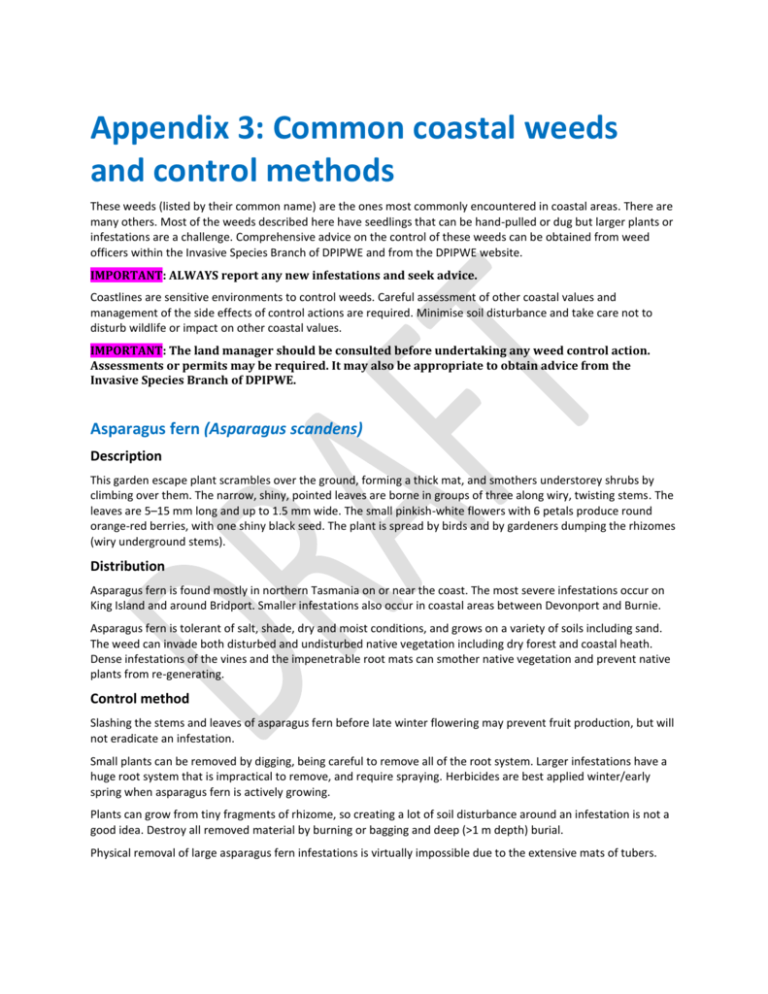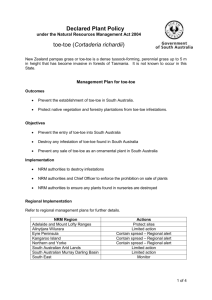Appendix 3: Common coastal weeds and control methods These
advertisement

Appendix 3: Common coastal weeds and control methods These weeds (listed by their common name) are the ones most commonly encountered in coastal areas. There are many others. Most of the weeds described here have seedlings that can be hand-pulled or dug but larger plants or infestations are a challenge. Comprehensive advice on the control of these weeds can be obtained from weed officers within the Invasive Species Branch of DPIPWE and from the DPIPWE website. IMPORTANT: ALWAYS report any new infestations and seek advice. Coastlines are sensitive environments to control weeds. Careful assessment of other coastal values and management of the side effects of control actions are required. Minimise soil disturbance and take care not to disturb wildlife or impact on other coastal values. IMPORTANT: The land manager should be consulted before undertaking any weed control action. Assessments or permits may be required. It may also be appropriate to obtain advice from the Invasive Species Branch of DPIPWE. Asparagus fern (Asparagus scandens) Description This garden escape plant scrambles over the ground, forming a thick mat, and smothers understorey shrubs by climbing over them. The narrow, shiny, pointed leaves are borne in groups of three along wiry, twisting stems. The leaves are 5–15 mm long and up to 1.5 mm wide. The small pinkish-white flowers with 6 petals produce round orange-red berries, with one shiny black seed. The plant is spread by birds and by gardeners dumping the rhizomes (wiry underground stems). Distribution Asparagus fern is found mostly in northern Tasmania on or near the coast. The most severe infestations occur on King Island and around Bridport. Smaller infestations also occur in coastal areas between Devonport and Burnie. Asparagus fern is tolerant of salt, shade, dry and moist conditions, and grows on a variety of soils including sand. The weed can invade both disturbed and undisturbed native vegetation including dry forest and coastal heath. Dense infestations of the vines and the impenetrable root mats can smother native vegetation and prevent native plants from re-generating. Control method Slashing the stems and leaves of asparagus fern before late winter flowering may prevent fruit production, but will not eradicate an infestation. Small plants can be removed by digging, being careful to remove all of the root system. Larger infestations have a huge root system that is impractical to remove, and require spraying. Herbicides are best applied winter/early spring when asparagus fern is actively growing. Plants can grow from tiny fragments of rhizome, so creating a lot of soil disturbance around an infestation is not a good idea. Destroy all removed material by burning or bagging and deep (>1 m depth) burial. Physical removal of large asparagus fern infestations is virtually impossible due to the extensive mats of tubers. Boneseed (Chrysanthemoides monilifera subsp. monilifera) Description Boneseed is a common evergreen shrub with attractive yellow daisy flowers in spring. It spreads by seed that remains viable years. Any disturbance such as fire is followed by mass germination of seed. Removal is a long-term process. Distribution Boneseed is common in several coastal areas of Tasmania, especially along the north coast east of Wynyard and on parts of the east coast. Boneseed is common in the Tamar Valley and in and around Hobart. Elsewhere in Tasmania boneseed occurs occasionally in disturbed bushland and coastal vegetation. Boneseed can invade the understorey of native forests and bushland, and is particularly invasive in coastal areas. Boneseed competes with native plants and reduces biodiversity, and dense infestations can be a significant fire hazard. Control method Seedlings and small plants are easily pulled up by hand. When bushes are pulled out, the ground disturbance may stimulate seed germination, making the boneseed problem worse. Follow-up treatment including pulling of seedlings or herbicide treatment is essential. For low to medium boneseed density, hand pull small plants and treat larger plants by cut-stump herbicide treatment. This minimises soil disturbance and damage to native vegetation. Boxthorn (Lycium ferocissimum) Description Boxthorn is a dense thorny bush up to 2 m high with small flowers in spring followed by orange berries in summer. Its bright green leaves are fleshy and 1–3 cm long. Distribution African boxthorn is found in coastal areas adjacent agricultural or urban areas, including King Island and Cape Barren Island. It is commonly found along fence-lines and beneath overhead wires, as well as along roadsides, railways and waterways. Control method The very dangerous thorns will penetrate gloves, shoes and tyres. Make absolutely sure when treating boxthorn that no thorny fragments are dropped where they can end up on the beach. Remember on a rocky shore waves can pick it up and wash it onto a nearby beach. It is very important to seek expert advice (it may be best have the plants sprayed in situ, provided damage to native vegetation is minimal). Handle boxthorn only while wearing very strong gloves, boots and clothing. Check first to see whether small animals live amongst it. Bridal creeper (Asparagus asparagoides) Description Bridal creeper is an aggressive climber over trees and shrubs. It has wiry stems and glossy, bright-green broad leaves. White flowers with 6 petals are produced along the stem in late winter–spring. Green berries ripen to red in spring. Bridal creeper spreads from extensive tubers and by seed. The tubers are very difficult to remove completely by digging. Distribution Bridal creeper is found mostly in northern Tasmania on or near the coast. The most severe Tasmanian infestations occur in the Tamar Valley, on Flinders Island, and on the east coast. Smaller infestations occur in coastal areas between Devonport and Burnie and in southern Tasmania around Hobart. Bridal creeper often occurs in moist gullies and waste areas near human habitation, and can invade native vegetation including dry forest and coastal heath. Dense infestations smother native vegetation and weaken trees. The thick mat of underground tubers also inhibits the root growth of other plants and prevents native plants from re-establishing. Control method Slashing the stems and leaves of bridal creeper before late winter flowering may prevent fruit production, but will not eradicate an infestation. Single bridal creeper plants or small infestations can be carefully dug out and destroyed before they flower. Ensure that all the root system is removed to avoid regeneration from rhizomes and tubers. Physical removal of established bridal creeper infestations is virtually impossible due to the extensive mats of tubers. Brooms (Genista monspessulana, Cytisus scoparius etc.) and tree lucerne (Chaemaecytisus palmensis) Description These large shrubs, and many other garden brooms, have masses of pea flowers in spring. Most brooms have yellow flowers, for example, english broom (Cytisus scoparius) and canary broom (Genista monspessulana). Canary broom hybridises with other species to form showier shrubs with larger leaves and more flowers. Tree lucerne has white flowers. They are all highly invasive weeds. Distribution English broom occurs throughout the settled areas of the state, being locally abundant on roadsides, waste areas, poor quality pastures and in disturbed bushland. Montpellier broom is widely distributed in Tasmania’s north, north-east and in the south. Control method Small plants can be hand pulled in spring when the ground is soft. Cutting seedlings when they are 5 to 10 cm high can provide effective control of regenerating plants. Larger shrubs should be cut close to ground level and the stumps painted with herbicide. Dense thickets can be slashed with a brushcutter and regrowth sprayed with herbicide. Preventing ground disturbance will help reduce the rate of invasion by brooms. Cape leeuwin wattle (Paraserianthes lopantha) Description This shrub or small tree can be confused with native species. Its feathery leaves fold up at dusk. The flowers are greenish-yellow in dense cylindrical spikes in the leaf axils. The red-brown pods are 8–10 cm long and 2 cm broad. Distribution Widespread on the east coast, south-east coast and estuaries (including Pitt Water and Orielton Lagoon), and also southern coasts and estuaries (including D'Entrecasteaux Channel and Derwent Estuary). Also present on islands in the region (eg Betsey Island). Relatively common in north east coastal communities, (Bridport, Tomahawk and Musselroe Bay). Control method Hand pull, even quite large plants can have shallow root systems but avoid soil disturbance which may stimulate germination of seed. Cut and paint larger plants. Marram grass (Ammophila arenaria) Description Marram forms dense tussocks up to 1.2 m high. It often dominates dunes. It has long runners and is easily identified by the shape of the ligule (the elbow where the leaf comes away from the stem) Distribution Widespread in all bioregions with the exception of the west and southwest bioregions where it is localised. A number of significant areas remain free of marram on the north and east coasts such as Cape Portland and Friendly Beaches. Control method For small infestations, dig out all rhizomes to a depth of 50cm if possible and repeat every 3 or 4 weeks until the rhizomes stop growing through to the surface. Monitor periodically thereafter. Where marram grass occurs ahead of the foredune on shifting beach sands manual control can generally be undertaken without risk to aboriginal heritage sites or dune stability. IMPORTANT: Always seek advice from your land manager before undertaking any control of marram grass. The level of sand disturbance required can impact on other values. Mirror bush (Coprosma repens) Description This popular garden shrub has large glossy leaves, and clusters of small whitish flowers in spring followed by orange berries in summer. Distribution As a garden escape in coastal communities across Tasmania. Common and widespread in coastal areas and drier inland areas throughout eastern, south-eastern and southern Tasmania. Also present on islands in the region. Relatively common in north east coastal communities, (Bridport, Tomahawk and Musselroe Bay). Control method Hand pull small plants (remove ALL roots). Cut and paint larger plants. Spanish heath (Erica lusitanica) Description This shrub looks very like a number of native heath plants. It is a multi-stemmed perennial up to 3 m tall with delicate dull-pink buds opening to tiny white bell-shaped flowers in autumn to winter. The fruits fall in early spring. It produces masses of seeds, is spreading rapidly and is very hard to get rid of, so look out for new infestations. Several other Erica species are becoming coastal weeds. Distribution Occurs in many areas of Tasmania, with significant infestations in the north (Tamar and Meander Valleys), northwest (from Devonport to Smithton), south (Collinsvale, D’Entrecasteaux Channel and the Huon Valley), and on the east coast (St Helens, Bicheno, and St Marys). Spanish heath occurs on degraded pastures, neglected areas and roadsides. Spanish heath also invades native vegetation types; including wet forest, dry forest, grassland and riparian (stream-side) areas, generally (but not always) where there has been some soil disturbance. Control method Seedlings or small plants can be hand-pulled or dug out, remove as much of the root system as possible and take care to minimise spread of weeds by timing works to avoid seed set or disposing of material carefully. Weed matting can kill Spanish heath and can achieve a 100% kill after 45 weeks. Larger infestations should be sprayed with an approved herbicide. Seek expert advice and permission from the land manager. Sweet pittosporum (Pittosporum undulatum) Description This low tree has clusters of creamy scented bell-shaped flowers in spring followed by yellow-orange fruit. The leaves have undulating edges. It hybridises with the indigenous Pittosporum bicolor, a small tree of wet gullies, with scattered two-toned yellow and purplish-red flowers and dark berries. Distribution Common and widespread in a wide range of habitats, including coastal areas, throughout eastern, south-eastern and southern Tasmania. Also present on islands in the region. Relatively common in north east coastal communities (Bridport, Tomahawk and Musselroe Bay). Control method Hand pull small plants, ensuring all roots are removed; cut and paint larger plants. Sea spurge (Euphorbia paralias) Description Sea spurge is a perennial sand dune shrub, up to 1 m tall, with multiple stems. The small fleshy leaves vary from oblong-shaped at the base to almost circular at the flowerheads. The minute flowers are cupped within green bracts. The seeds are readily dispersed by wind or water. Seedlings rapidly send down a deep taproot. Sea spurge first establishes at the strandline and can quickly take over native beach plant communities. Its different growth rate and habit alter the sand accretion and dune form on beaches, causing loss of nesting sites for shorebirds. Distribution Already well established in the Furneaux islands and across the north and northwest of Tasmania. It is rapidly spreading southwards. It is important to protect the east and south coast from further infestation and to also protect northern beaches that still retain undisturbed beach vegetation or natural sand blows. Control method Sea spurge seedlings can be hand-pulled, but wear protective clothing to protect skin and eyes from the sap. A toxic milky sap oozes from the broken stems of sea spurge. Take great care to avoid getting it into your eyes or on your skin, where it can cause severe irritation. If affected, seek medical attention. Small seedlings can occur in thousands and these are best left to thin out naturally and pulled the following year. Follow-up will be required as seeds germinate and fragments of broken taproots re-sprout. Substantial control can be achieved by this method but it may take 4 or 5 years of concerted effort. Chemical control is also possible but expert advice and approval from your land manager is required for herbicide use on beaches. Rice grass (Spartina anglica) Description Rice grass is a sturdy erect grass growing to 130 cm high. Its stiff leaves are 45 cm long, 15 mm wide and taper to a long slender point. The flowering head has up to six erect flowering spikes up to 20 cm long. Distribution Rice grass is a hardy saltmarsh grass that invades the upper intertidal regions of estuaries. It spreads rapidly by seed, or by fragments breaking off and floating away. Rice grass changes tidal sand and mud flats to grasslands, depriving shorebirds, fish and other animals of habitat. It has spread to estuaries along the north and east coasts and into the Derwent Estuary. Control method Seedlings are easily removed by hand but the larger, more established patches are very difficult to eradicate. Contact a DPIPWE Regional Coordinator - Invasive Species Management. It is important to seek expert advice and the permission of the land manager before controlling rice grass. Beware – mudflats can be dangerous to work on. Never work alone and take precautions to avoid getting stuck. Sea wheat grass (Thinopyrum junceiforme) Description Sea wheat grass is a low dune grass (10–50 cm high) with long, creeping, rigid rhizomes. It forms a low but sometimes very dense sward on beaches. The leaves are bluish-green and widely spreading, up to 30 cm long and 5 mm broad; some with margins rolled in. The upper leaf surface is covered in dense hairs. The narrow flowers, carried on erect stems, are arranged alternately in one plane like a rye grass. The flowers are 5–20 cm long, and borne in December and January, becoming pale wheat in colour when mature. Distribution It is widespread along the north coast from Marrawah to Cape Portland, where it extends into the Tamar and Bridport estuaries, and possibly into other estuaries. Control method Seek expert advice and permission from the land manager. Digging out the rhizomes can control small areas of sea wheatgrass. Care must be taken to remove as much as possible and monitor regularly for re-emerging plants. Effective aquatic registered herbicides are available for use on sea wheatgrass. Areas where control has been undertaken should be monitored annually for germinating seedlings until no further plants are found for a few years in a row. Pyp grass (Erharta villosa) Description It is notable for growing up to 2 m in height from a creeping rhizome. The leaves are flat or rolled, up to 20 cm long and 4 mm broad, with wavy margins. The flowers cluster in heads up to 20 cm long. The flowers are covered in long soft hairs, and are straw-coloured with a purplish tinge. Distribution This grass is found only at a few sites in Tasmania, including King Island and the Arthur–Pieman areas. Report any new infestations. Control method Seek expert advice and permission from the land manager. Digging out the rhizomes can control small areas of pyp grass. Care must be taken to remove as much as possible and monitor regularly for re-emerging plants. Beach daisy (Arctotheca populifolia) Description This South African daisy is a low, spreading plant that forms small clumps on beaches. It is distinguished from native beach daisies by its fleecy leaves – the broad, soft, pale grey-green leaves and the stems are covered with hairs. The flowers are bright yellow and about 5 cm wide, growing on 25 mm stalks. Distribution The only known infestation is on Flinders Island, but this weed is capable of invading large areas of foredunes and accumulating sand. Report any new infestations. Control method Small infestations of beach daisy can be controlled by hand pulling. Areas where control has been undertaken should be monitored for seedlings annually until no further plants are found. Blackberry (various species) Description Blackberries are spiny, perennial (long-lived) shrubs with trailing stems which can produce dense thickets. The canes may be erect, arching or trailing and they can reach 6 m in length. Blackberries thickets can reach two or more meters in height and cover many square meters in area. Distribution Blackberries occur in all settled areas of Tasmania. Blackberries prefer open situations and occur as a weed in disturbed coastal vegetation, along stream-sides, roadsides, tracks and fence lines. Control method It is important to seek expert advice and permission from your land manager before tackling Blackerry. Physical removal by repeated slashing may limit the spread of blackberries but it is not an effective method of control when used alone. Seedlings and regrowth from root fragments can also be sprayed for one or two seasons after physical removal. IMPORTANT: Identify which species it is, not only to distinguish it from the native raspberry, but also to check whether it is a species of European origin, or American or Asian, as they react differently to chemical treatments. ALERT: There are strict legal guidelines around the use of chemicals to control blackberry in public areas, to protect people from inadvertently ingesting chemicals.








